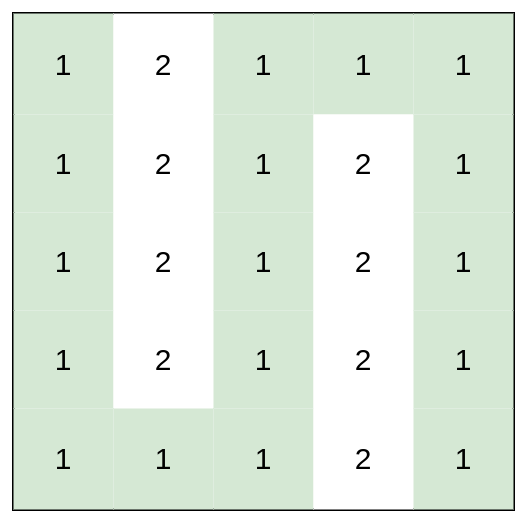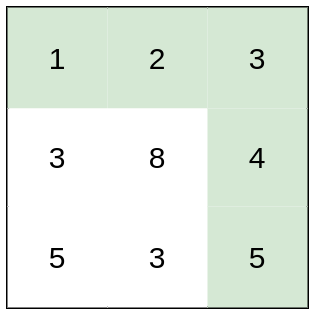输入:heights = [[1,2,3],[3,8,4],[5,3,5]]
输出:1
解释:路径 [1,2,3,4,5] 的相邻格子差值绝对值最大为 1 ,比路径 [1,3,5,3,5] 更优。
示例 3:

输入:heights = [[1,2,1,1,1],[1,2,1,2,1],[1,2,1,2,1],[1,2,1,2,1],[1,1,1,2,1]]
输出:0
解释:上图所示路径不需要消耗任何体力。
提示:
rows == heights.length
columns == heights[i].length
1 <= rows, columns <= 100
1 <= heights[i][j] <= 106
二、解决方法
1. 二分+bfs(官方题解)
package com.lxf.test3;
import java.util.LinkedList;
import java.util.Queue;
class Solution {
int[][] dirs = {{-1, 0}, {1, 0}, {0, -1}, {0, 1}};
public int minimumEffortPath(int[][] heights) {
int m = heights.length;
int n = heights[0].length;
int left = 0, right = 999999, ans = 0;
while (left <= right) {
int mid = (left + right) / 2;
Queue<int[]> queue = new LinkedList<int[]>();
queue.offer(new int[]{0, 0});
boolean[] seen = new boolean[m * n];
seen[0] = true;
while (!queue.isEmpty()) {
int[] cell = queue.poll();
int x = cell[0], y = cell[1];
for (int i = 0; i < 4; ++i) {
int nx = x + dirs[i][0];
int ny = y + dirs[i][1];
if (nx >= 0 && nx < m && ny >= 0 && ny < n && !seen[nx * n + ny] && Math.abs(heights[x][y] - heights[nx][ny]) <= mid) {
queue.offer(new int[]{nx, ny});
seen[nx * n + ny] = true;
}
}
}
if (seen[m * n - 1]) {
ans = mid;
right = mid - 1;
} else {
left = mid + 1;
}
}
return ans;
}
}
2. 并查集+克鲁斯卡尔算法(参照官方题解)
package com.lxf.bfs;
import java.util.PriorityQueue;
public class MinimumEffortPath {
public static void main(String[] args) {
MinimumEffortPath m = new MinimumEffortPath();
m.minimumEffortPath(new int[][]{{1,2,2},{3,8,2},{5,3,5}});
}
int[] parent;
int[] rank;
public int minimumEffortPath(int[][] heights) {
int row=heights.length;
int col=heights[0].length;
parent=new int[row*col];
rank=new int[row*col];
PriorityQueue<int[]> pq = new PriorityQueue<>((arr1, arr2) -> arr1[2] - arr2[2]);
for (int i = 0; i < row; i++) {
for (int j = 0; j < col; j++) {
int index=i*col+j;
parent[index]=index;
if(i>0){
pq.offer(new int[]{index-col,index,Math.abs(heights[i][j]-heights[i-1][j])});
}
if(j>0){
pq.offer(new int[]{index-1,index,Math.abs(heights[i][j]-heights[i][j-1])});
}
}
}
int min=0;
while(!pq.isEmpty()){
int[] nums = pq.poll();
union(nums[0],nums[1]);
if(find(0)==find(row*col-1)){
min=nums[2];
break;
}
}
return min;
}
public int find(int index){
while(index!=parent[index]){
parent[index]=parent[parent[index]];
index=parent[index];
}
return index;
}




